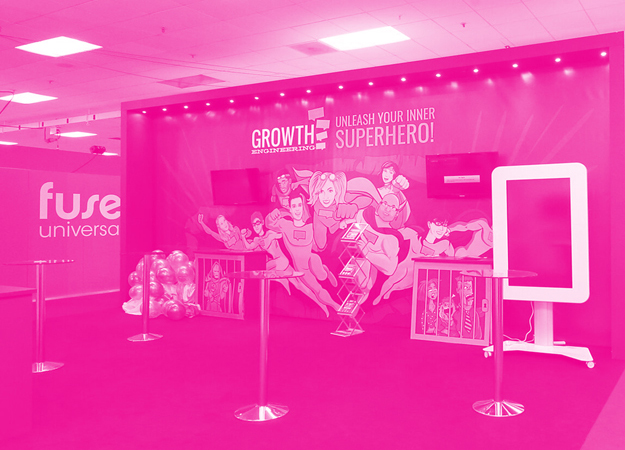How To Create The Perfect Exhibition Stand Explained!

Attending a show shouldn’t be about getting out of the office and relaxing.
There has to be an objective, whether it’s to increase awareness of your brand, demo your latest product or build & deepen relationships with existing customers. Whatever the objective is, this needs to be clear to the show attendees who walk by your stand. The statement you make always influences the reputation of your brand and the future of your business. So your exhibition stand needs to be the best it can be within the constraints of your budget. Expositionists are committed to helping clients succeed in the exhibition space by designing bespoke exhibition stands that separate them from the competition in distinctive and memorable ways. They do so by following a process that will ensure the client gets exactly the right stands that are custom-built for them. Here’s the process explained below…
Here’s the process explained below
Exhibition Stand Design
The first step is to talk with the client to discuss their goals and objectives. Exhibition stand design starts with understanding those goals, and then builds on it with innovative design ideas meant to reach these goals. Designers look at everything from graphics to lighting to the layout of the exhibition space.
Throughout the design phase, the client may want changes based on a change of brief. Designers have to be flexible enough to accommodate those changes without compromising the integrity and vision of the project. This sometimes requires a delicate balance, but the best designers in the business are more than up to the challenge.

Measure twice, and cut once.


Although the factory invests continually in modern machinery there is plenty of traditional skill on show. Pencils, Rulers and tape measures are never far away.
Arguably one of the most important and time-consuming parts of the build process is the initial cutting of the materials needed to build your cabinets. We take a lot of time and care in this part of the process because it needs to be right the first time, a misplaced cut at this stage can spell disaster later on! A Careful eye is applied at each stage as the sections of your cabinet are cut, detailed and made ready for assembly

Everybody loves a dovetail joint
Details and Construction

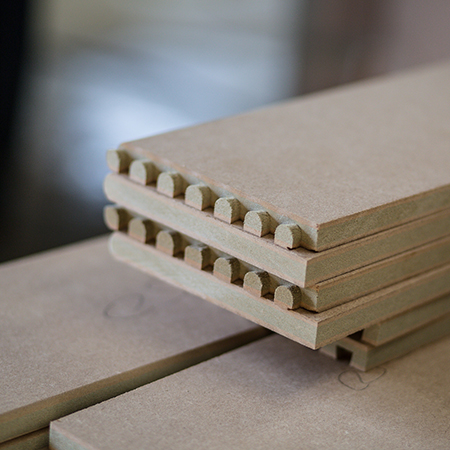
With the strength and quality of modern epoxy glues it isn’t strictly necessary to use traditional Tongue and groove, mortise and tenon or dovetail jointing, but when hand-building a piece of quality furniture it somehow just feels right to use these tried and tested traditional techniques. So we do!
It’s just a shame we always paint over them!
Drawer boxes are always an important part of any piece of furniture, so we like to make sure ours are built properly. All the drawer boxes in the Island Breeze or Oxford furniture collections are built with 20mm thick front side and back sections, the front is dovetail jointed for a correct boxed finish and the rear is glued and doweled. The bottom of the drawers are made using a full 10mm thick board, so no saggy bottoms with these drawers. They are all assembled by hand and tested for strength.
The best finish requires the best materials
Making sure the final finish of your piece of furniture has the perfect smooth look that we are renowned for starts way before the paint shop. The engineered timber we use to build the carcass of the Island Breeze and Oxford Furniture is the best available.


Whilst we use grade one American Oak for the beautiful Oak tops of your furniture and trust us, they really are lovely, the main carcass of the Island Breeze and Oxford Furniture is built using high-density engineered timber. This engineered timber is made using a combination of hardwood and epoxy resin which is formed under intense pressure to create a very dense, stable material which is the perfect base for building painted furniture.
Why do we use an Engineered Timber rather than a solid wood construction? Simple really, the Island Breeze and Oxford collections are our premium collections and its the best material for the job.


The best finish requires the best materials
Our engineered timbers have superior stability when compared to hardwood sections and are resistant to expansion or contraction with changing levels in temperature or humidity. Wood inevitably moves slightly as the temperature or humidity in your home changes, usually from season to season. That’s ok for a non-painted product but if that happened with our painted furniture the paint would obviously crack and ruin the appearance of your furniture. The only drawback is that with a density of around 900kg/m3, the engineered timbers mean that our furniture is very heavy, but that’s not such a bad thing. We also select engineered timbers which are designed for optimal uniformity which, along with the fact that they are entirely free of knots, helps us to create the perfectly smooth finish you expect.

Other select materials
All of the legs on the Island Breeze and Oxford furniture, whether turned or straight on dining tables, coffee tables and dressing tables are built using ‘unsorted grade’ Nordic Red Pine. Contrary to how it may sound the ‘unsorted’ grade is the best available on the open market. It is uniform and almost entirely knot-free so is good for painting and provides the additional strength needed for a supporting leg.
The first-grade American Oak that we use for the cabinet tops (where selected) and for coffee tables and all of the dining tables is sustainably soured and always clean, uniform and largely knot-free. Of course, being a natural product these timbers have beautiful grain patterns which will vary between each piece. Timbers are hand-selected for each piece we build.

American oak, not English?
That’s right, and why not English Oak? well, that’s an easy one……..there isn’t any! We used it all about 200 years ago I’m afraid building battleships, conquering the Caribbean and fighting the French. So whatever your political standing on our past exploits it didn’t leave much commercial forest in the UK. Virtually all of the Oak woodland in the UK is ancient protected forest and whilst there is a tiny tiny amount of Oak timber created through natural forestry management this is reserved for special and heritage building projects. American White Oak is the major export timber for the United States and is used all over the world for making fine furniture. It is both managed and sustainable.
More information on the sustainability of American Hardwoods can be found here.
Let’s put it all together



Using the traditional skills only found in a classic workshop environment the carefully prepared sections of your furniture are assembled and ready for the the paint shop. It is at this stage that the benefits of hand production really start to stand out. Each joins, each facing and every part of the furniture is inspected as it is being built, and any slight adjustments can be made here and now to ensure the finished article is perfect.


And now for the fun part
Truffle, Cloud, Stone or Ivory; whichever of the great colour choices you decided upon it all happens in the hands of our skilled paint shop operators They may have the most fun job of the whole process but the paint shop is certainly the most serious place in the entire factory.

What about the paints we use?
Our commitment to using only the best materials for the Island Breeze and Oxford collections continues in the paint shop. The paints are supplied by a very well-respected British paint manufacturer who among other things also supplies all the paint to Sunseeker Yachts. In our opinion, if it’s good enough for a multi-million-pound motor yacht, then it might just be good enough for us to paint your furniture with.

How tough is the finish?
All the paints we use are Catalysed paints. Catalysed paint, unlike most other types of paint, contains a hardener that allows it to cure and dry more quickly. Once cured the colour takes on a very smooth finish and a hardness almost akin to a plastic coating. Most paint used by car manufacturers is catalysed paints so they are very tough.
Other Advantages of Catalysed Paint The most significant advantage of catalysed paint over usual types of paint is that it does not allow solvents through the surface. Most paints, over time, allow microscopic holes to form after they’ve dried, which enables liquids, air and other elements in the environment to deteriorate the paint. Because catalysed paint dries more quickly, these holes take much longer to form, and the coat, therefore, lasts much longer than conventional paints.


We fit temporary transport feet to your furniture so that we can safely move it around in the factory and even these will get a coat of paint
If these feet are still in place when the furniture arrives with you Don’t panic at their appearance, just twist them off and throw them away!

There is only one way to get the perfect finish on your painted furniture and that is slowly and carefully. Each piece is carefully prepared before entering the first stage of the paint shop. Here your furniture receives a base coat of primer, in either white or grey depending on the chosen final colour. Once this coat has dried the furniture is again inspected for any flaw which might show through to the top surface. Only when we are fully satisfied is the furniture passed through to the top coat sprayers. Spraying the top coat is a highly skilled job where experience counts above all else. Only two people in the whole factory have this skill level and it is nice to know that one or other of them will have personally painted your Furniture.
That’s a Wrap!
Carefully wrapped & ready to ship.


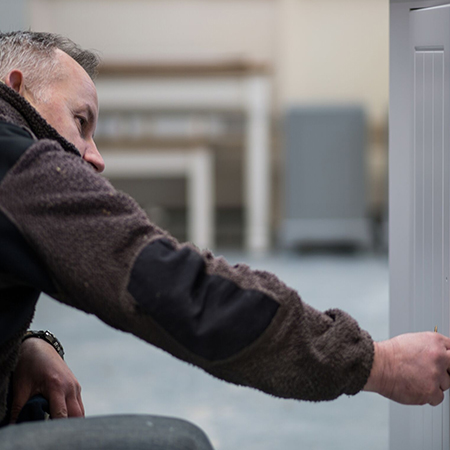
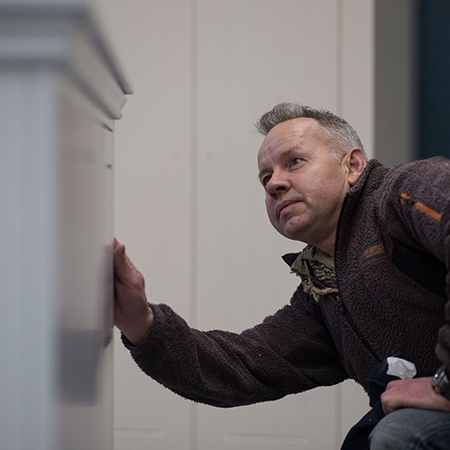
The painted furniture is moved from the paint shop to an infra-red drying oven where it sits for a full 24 hours to ensure the paint is fully cured. Even when fully cured we like to leave the furniture to air for a good length of time which can be anything up to seven days. Before the furniture is finally wrapped ready to ship to your home each and every piece is given a good once over as a final quality check.
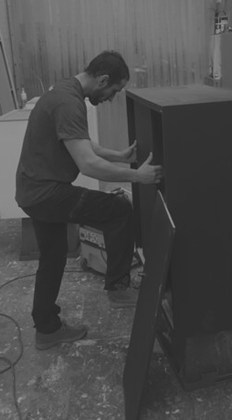
Exhibition Stand Manufacture & Building
The second step is to manufacture and build the bespoke exhibition stand according to the approved design. Expositionists’ builders create everything from scratch in their UK warehouse, using high-quality materials they know will last, but more importantly, will provide a quality finish. Furthermore, the craftsmanship is second to none. Builders are experts in exhibition stand manufacture and do not compromise quality at any stage of the build. The length of time required for manufacture depends on what a particular design calls for. The stand represents the client’s brand and needs, so whether a stand is built on a limited budget or an endless one, the care and attention of the build is the same.
Exhibition Stand Installation
The build of the stand doesn’t stop with the manufacturing in the warehouse. The final build is completed on-site with the same team.
The last step in creating the perfect exhibition stand is on-site installation. This is where the stand is fully assembled and where the electrics and added, bringing TVs, iPads and other technology to life.


Exhibition Stand Logistics
Logistics has to consider not only the skeleton of an exhibition stand but also lighting, audio-visual components and other additional stand features. The finished product needs to be able to withstand any amount of travel as well. Everything has to hold up whether it is being transported locally, regionally or around the world.

Project Management
Throughout each step, there is a dedicated project manager. They work with the client at every point in the process, making sure the stand that is delivered meets the requirements of the team and that the stand is installed, without any issues. And of course, if issues do arise, they are on hand to resolve them. They build a relationship with the client and become the central contact point for everyone & everything.
A Strategy That Works
Expositionists have not developed their strategy for creating the perfect exhibition stand as a mere marketing tool. They put it into practice every day. What’s more, it works. Expositionists recently created a bespoke exhibition stand for Growth Engineering at February’s Learning Technologies event at Olympia, London – the stand was a tremendous success.
Not only did the Expositionists’ team create an exhibition stand that drew the attention of attendees throughout the event but they also built something that won the award for ‘Best Stand at Show’. What they designed and built was an amazing-looking stand, that combined with the team on the stand to command the attention of everyone who walked by. It was an incredible presentation of the stand & team coming together under one objective.
Expositionists specialise in creating bespoke exhibition stands that are both effective and budget-friendly. It is their belief that clients don’t have to spend a small fortune to get an exhibition stand that will be effective in every environment. Rather, the smallest and most affordable stand can be just as effective.
Award-winning, custom-designed exhibition stands are the Expositionists speciality and have proven they know what they’re doing on more than one occasion. They should be at the top of the list for any company looking for a new exhibition stand, regardless of budget!


